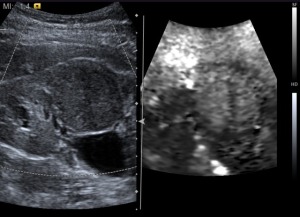by
Carol Ko, Staff Writer | July 18, 2013

Biopsy-proven renal cell cancer
is characterized using Virtual Touch imaging
With the announcement of Siemens' U.S. Food and Drug Administration clearance for its elastography product, Virtual Touch, it seems elastography is gaining momentum in the U.S. market.
The product has been available outside the U.S. since 2008.
Elastography works by measuring tissue stiffness to detect tumors, which are on average 5-28 times stiffer than healthy surrounding tissue. The technology provides crucial additional information for physicians, giving them additional diagnostic criteria to help them arrive at a more accurate conclusion around suspicious lesions.



Ad Statistics
Times Displayed: 173378
Times Visited: 3165 For those who need to move fast and expand clinical capabilities -- and would love new equipment -- the uCT 550 Advance offers a new fully configured 80-slice CT in up to 2 weeks with routine maintenance and parts and Software Upgrades for Life™ included.
Using this tool, they may be better able to decide on a course of treatment and proceed with greater confidence, according to Siemens.
While several elastography products are already out in the market today, these systems rely on manual compression to measure tissue strain.
"With standard manual elastography techniques, depending on the experience of the person performing the compression and how much compression they use, the image may look very different," said Dr. Dirk-Andre Clevert, section chief of the Interdisciplinary Ultrasound Center, University Hospital Grosshadern, Munich, Germany, to DOTmed News. The center has been using the Virtual Touch elastography imaging technology on the Siemens Acuson S2000 Ultrasound for five years.
Now, Siemens is only one of two manufacturers in the United States (the other being SuperSonic Imagine) to offer an elastography system that uses acoustic radiation force impulse imaging to put stress on the tissue in place of manual compression.
While elastography's sensitivity offered numerous advantages, there is big advantage to be gained from eschewing manual compression. Ultrasound's major weakness as a modality is its user dependence, so automating this step ensures that the results are more reproducible from user to user.
One of the most obvious applications for this new technology is in breast imaging — a notoriously difficult part of the body to scan and interpret. After a mammography screening picks up a suspicious lesion, elastography systems such as Virtual Touch could be used to help clarify the nature of the lesion by measuring its tissue stiffness.
The technology may also help doctors quantify the lesion in a way that helps them positively identify cancers. "The same malignant lesion is larger in an elastogram than in a traditional 2-D image," explained Jon Benson, director of clinical applications in product portfolio and strategy at Siemens Ultrasound, to DOTmed News.


roger rae
death due to nuclear camera failure
July 18, 2013 02:21
This should be a wake up call for all. It seems strange that the FDA does not have published reports of all incidence resulting in death or injury. The FAA does and I believe this info. is very helpful.
to rate and post a comment